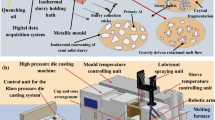Abstract
Continuous extruding/ extending forming process for A20/7 alloy in semisolid state was proposed through installing extending die at the outlet of shearing-cooling-rolling (SCR) machine. A series of experiments to produce flat bar of A 2017 alloy were carried out. The forming process, metal flow behavior in die and microstructure and mechanical property of products were investigated. It is shown that if the pouring temperature of melt was higher, the die was filled with semi-solid slurry with low solid fraction and periodical cracks would occur on the product surface; If its pouring temperature was lower or the preheating temperature of die was lower, semisolid slurry would solidify rapidly and block the die after entering the cavity. The analysis of mass flow trace shows that the semi-solid slurry moves forward layer by layer and fills the die extending caviiy in radiation manner and the velocity of mass flow in the central area of extending cavity and exit of mould is the maximum, and then decreases gradually from the center to both sides of die wall. By increasing the die extending angle, the velocity of mass flow becomes more homogeneous. Under rational process control and die design, the A2017 flat bar with transverse section of 10 × 50 mm and with good surface and fine equiaxed grains can be obtained by continuous extruding/ extending forming process. The product’s tensile strength and elongation are 420.5 MPa and 14.2%, respectively.
Similar content being viewed by others
References
D B Spencer, R Mehrabian, M C Flemings. Rheological Behavior of Sn-15 Pct Pb in the Crystallizatíon Range.Metall. Tram., 1972, 3(7): 1925–1932
M C Flemings, R G Riek, K P Young. Rheocasting.Mater. Sci. Eng., 1976, 25(2): 103–117
M C Flemings. Behavior of Metal Alloys in the Semi-solid State.Metall. Trans., 1991, A22(5): 957–981
D H Kirkwood. Semi-solid Metal Processing.Inter. Mater. Reviews, 1994, 39(5): 173–189
S J Luo, J F Jiang, Z M Du. New Research Development, Industrial Application and Some Thinking of Semi-solid Metal Forming.J. Mechanical. Eng., 2003, 39 (11): 52–60
S Turenne, N Legros, S Laplante. Mechanical Behavior of Aluminum Matrix Composite during Extrusion in the Semi-solid State.Metall. Mater. Trans., 1999, A30(4): 1137–1146
T J Chen, Y Hao, J Sun. Effects of Compression Parameters on Deformation Behaviors of Semi-solid ZA27 Alloys.J. Wuhan University of Technology-Mater. Sci. Ed., 2003, 18(3): 9–14
J Dong, J Z Cui, Q C Le,et al. Liquidus Semi-continuous Casting, Reheating and Thixoforming of a Wrought Aluminum Alloy 7075.Mater. Sci. Eng., 2003, A345: 234–242
D H Lee, P K Seo, C G Kang. Die Design by Filling Analysis of Semi-solid Injection Forging Process and their Experimental Investigation.J. Mater. Processing Technol., 2004, 147(1): 45–50
E R Defreitas, E Ferracini, M Ferrante. Microstructure and Rheology of an AA2024 Aluminum Alloy in the Semi-solid State, and Mechanical Properties of a Back-extruded Part.J. Mater. Processing Technol., 2004, 147(4): 241–249
W M Mao, Y L Bai, J Chen. Research Development of Rheocasting for Semi-solid Alloy.Special Casting and Nonferrous Alloys,2004,(2): 4–8
X J Yang, H M Guo. Developing Situation and Counter Measure of Semi-solid Slurry-making Technology.Jiangxi Metallurgy, 2003, 23(6): 75–79
Y X Jiang, S S Xie, X G Li. New Technology for Semi-solid Metal Slurry Preparation.Forging Technology, 2003, (6): 41–47
Kiuchi M, Sugiyama S. A New Process to Manufacture Semi-solid Alloys.ISIJ International, 1995, 35 (6): 790–797
S C Wang, J L Wen, Y B Chen,et al. Microstructural Evolution of A2017 Semi-solid Alloys Produced by SCR Technology.Chin. J. Nonferrous Met., 2004, 14(4): 627–632
R G Guan, J L Wen, X H Liu. Finite Element Modeling Analysis of Aluminum Alloy 2017 Thermal/fluid Multiple Fields during a Single Roll Stirring Process.Mater. Sci. Tech- nol., 2003, 19(4): 503–506
H K Jung, C G Kang. Reheating Process of Cast and Wrought Aluminum Alloys for Thixoforging and Their Globularization Mechanism.J. Mater. Processing Technol., 2000, 104(2): 244–253
S C Wang, Y B Chen, J L Wen. FEM Analysis of Metal Flow Behavior during Continuous Extruding/ extending Forming in Semi-solid State.J. Northeastern University (Natural Science), 2004, 25 (9): 859–862
Author information
Authors and Affiliations
Corresponding author
Additional information
Funded by the National Natural Science Foundation of China (No. 50274020 and Baoshan Iron & Steel Corporation of Shanghai
Rights and permissions
About this article
Cite this article
Shuncheng, W., Furong, C., Yinglong, L. et al. Continuous extruding extending forming of semi-solid A2017 alloy. J. Wuhan Univ. Technol.-Mat. Sci. Edit. 21, 76–79 (2006). https://doi.org/10.1007/BF02861476
Received:
Accepted:
Issue Date:
DOI: https://doi.org/10.1007/BF02861476




